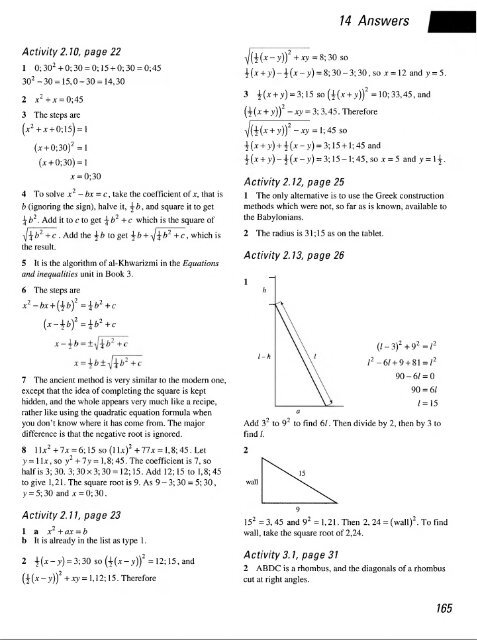history of mathematics - National STEM Centre
history of mathematics - National STEM Centre
history of mathematics - National STEM Centre
Create successful ePaper yourself
Turn your PDF publications into a flip-book with our unique Google optimized e-Paper software.
Activity 2.10, page 22<br />
1 0;30 2 +0;30 = 0;15 + 0;30 = 0;45<br />
30 2 -30 = 15,0-30 = 14,30<br />
2 jc 2 +jt = 0;45<br />
3 The steps are<br />
(jc + 0;30) 2 =1<br />
(* + 0;30) = l<br />
x = 0;30<br />
4 To solve x2 - bx = c , take the coefficient <strong>of</strong> x, that is<br />
b (ignoring the sign), halve it, \b, and square it to get<br />
jb 2 . Add it to c to get jb 2 + c which is the square <strong>of</strong><br />
^b 2 +c . Add the \b to get jb + ^b 2 +c, which is<br />
the result.<br />
5 It is the algorithm <strong>of</strong> al-Khwarizmi in the Equations<br />
and inequalities unit in Book 3.<br />
6 The steps are<br />
7 The ancient method is very similar to the modern one,<br />
except that the idea <strong>of</strong> completing the square is kept<br />
hidden, and the whole appears very much like a recipe,<br />
rather like using the quadratic equation formula when<br />
you don't know where it has come from. The major<br />
difference is that the negative root is ignored.<br />
8 Ilx 2 +7jc = 6;15 so (ILt) 2 +77x = 1,8; 45. Let<br />
y = 1 Ijc, so y 2 + ly = 1,8; 45. The coefficient is 7, so<br />
half is 3; 30. 3; 30x3; 30 = 12; 15. Add 12; 15 to 1,8; 45<br />
to give 1,21. The square root is 9. As 9 - 3; 30 = 5; 30,<br />
y = 5; 30 and x = 0; 30.<br />
Activity 2.11, page 23<br />
1 a x 2 +ox = b<br />
b It is already in the list as type 1.<br />
2 l(;c-.y) = 3;30 so (i(x-y)f = 12; 15, and<br />
(^(x-y)) 2 +xy = 1,12; 15. Therefore<br />
}(x-y)) +xy =8; 30 so<br />
14 Answers<br />
3 ±(x + y) = 3;l5 so (-^(x + y)) = 10; 33, 45, and<br />
( 2 (x + y}} 2 ~ W = 3 '> 3' 45 • Therefore<br />
and<br />
x = 5<br />
Activity 2.12, page 25<br />
1 The only alternative is to use the Greek construction<br />
methods which were not, so far as is known, available to<br />
the Babylonians.<br />
2 The radius is 3 1 ; 1 5 as on the tablet.<br />
Activity 2.13, page 26<br />
l-h<br />
222<br />
(/-3)+9 2 =/<br />
90 - 61 = 0<br />
90 = 61<br />
1 = 15<br />
Add 3 2 to 9 2 to find 61. Then divide by 2, then by 3 to<br />
find /.<br />
2<br />
wall<br />
15<br />
15 2 = 3,45 and 9 2 =1,21. Then 2, 24 = (wall) 2 . To find<br />
wall, take the square root <strong>of</strong> 2,24.<br />
Activity 3.1, page 31<br />
2 ABDC is a rhombus, and the diagonals <strong>of</strong> a rhombus<br />
cut at right angles.<br />
165
















